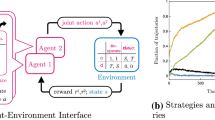Abstract
Conflict of interest may be modeled, heuristically, by the iterated Prisoner's Dilemma game. Although several researchers have shown that the Tit-For-Tat strategy can encourage the evolution of cooperation, this strategy can never outscore any opponent and it does poorly against its clone in a noisy environment. Here we examine the family of Pavlovian strategies which adapts its play by positive and negative conditioning, much as many animals do. Mutual cooperation will evolve in a contest with Pavlov against a wide variety of opponents and in particular against its clone. And the strategy is quite stable in a noisy environment. Although this strategy cooperates and retaliates, as does Tit-For-Tat, it is not forgiving; Pavlov will exploit altruistic strategies until he is punished by mutual defection. Moreover, Pavlovian strategies are natural models for many real life conflict-of-interest encounters as well as human and computer simulations.
Similar content being viewed by others
References
Axelrod, R.: 1984,The Evolution of Cooperation, New York: Basic Books.
Axelrod, R. and Dion, J.: 1987, ‘Annotated bibliography on the evolution of cooperation’, Institute of Public Policy Studies, Ann Arbor: University of Michigan.
Axelrod, R. and Dion, J.: 1988, ‘The further evolution of cooperation’,Science 242, 1385–1390.
Bendor, J., Kramer, R. M. and Stout, S.: 1991, ‘When in doubt ... Cooperation in a noisy Prisoner's Dilemma’,J. Conflict Resolution 35, 691–719.
Bixenstine, V. W. and Gaebelin, J. W.: 1971, ‘Strategies of real opponents in eliciting cooperative choice in a prisoner's dilemma game’,J. Conflict Resolution 15, 157–166.
Burton, D.: 1989,Elementary Number Theory, 2nd. ed., Dubuque: W C Brown.
Conybeare, J.: 1987,Trade Wars, New York: Columbia University Press.
Dawkins, R.: 1989, The Selfish Gene, New Edition, Oxford: Oxford University Press.
Donninger, C.: 1986, ‘Is it always efficient to be nice?’ inParadoxical Effects of Social Behavior, A. Dickmann and P. Mitter (Eds.), Heidelberg: Physica Verlag, pp. 123–134.
Kemeny, J. and Snell, J.: 1976,Finite Markov Chains, New York: Springer-Verlag.
Komorita, S. S., Hilty, J. A. and Parks, C. D.: 1991, ‘Reciprocity and cooperation in social dilemmas’,J. Conflict Resolution 35, 494–518.
Kraines, D. and Kraines, V.: 1989, (PPD) ‘Pavlov and the Prisoner's Dilemma’,Theory and Decision 26, 47–79.
Lombardo, M.: 1985, ‘Mutual restraint in tree swallows’,Science 227, 1363–1365.
Macy, M.: 1989, ‘Walking out of social traps’,Rationality and Society 1, 197–219.
Macy, M.: 1991 ‘Learning to cooperate: Stochastic and tacit collusion in social exchanges’,American J. Sociology 97, 808–843.
Mailath, G. J.: ‘Introduction: Symposium on evolutionary game theory’,J. Economic Theory 57, 259–277.
May, R.: 1987, ‘More evolution of cooperation,’Nature 327, 15–17.
MATLAB (386 version): 1991, The Math Works, Natick, MA.
Maynard Smith, J.: 1982,Evolution and the Theory of Games, Cambridge: Cambridge Univ. Press.
Molander, P.: 1985, ‘The optimal level of generosity in a selfish uncertain environment’,J. Conflict Resolution 29, 611–618.
Mueller, U.: 1987, ‘Optimal retaliation and optimal cooperation’,J. Conflict Resolution 31, 692–724.
Nowak, M. and Sigmund, K.: 1989, ‘Game-dynamical aspects of the Prisoner's Dilemma’,App. Math. and Comp. 30, 191–213.
Nowak, M. and Sigmund, K.: 1990, ‘The evolution of stochastic strategies in the Prisoner's Dilemma’,Acta Applic. Math. 20, 247–265.
Opp, K-D.: 1988, ‘Spontaneous order and Tit for Tat’,J. Institutional and Theoretical Economics 144, 374–385.
Orkin, M.: 1987, ‘Balanced strategies for Prisoner's Dilemma’,J. Conflict Resolution 31, 186–191.
Patchen, M.: 1987, ‘Strategies for eliciting cooperation from an adversary’,J. Conflict Resolution 31, 164–185.
Rapoport, A. and Chammah, A. M.: 1965,Prisoner's Dilemma, Ann Arbor: University of Michigan Press.
Shubik, M.: 1970, ‘Game theory, behavior, and the paradox of the Prisoner's Dilemma’,J. Conflict Resolution 14, 181–193.
Simon, H.: 1991, ‘A mechanism for social selection and successful altruism’,Science 250, 1665–1668.
Author information
Authors and Affiliations
Rights and permissions
About this article
Cite this article
Kraines, D., Kraines, V. Learning to cooperate with Pavlov an adaptive strategy for the iterated Prisoner's Dilemma with noise. Theor Decis 35, 107–150 (1993). https://doi.org/10.1007/BF01074955
Issue Date:
DOI: https://doi.org/10.1007/BF01074955




